Bigfoot Encounters
Argosy
Magazine, February 1971
By Odette Tchernine
Soviet Investigations have turned up reports of human-like creatures who have lived for years in Russian Villages and even born human children.
Yetis and abominable snowmen living in Russian villages; working and even bearing children by humans? Incredible as it seems, comprehensive research in Russia, unreported until now, shows that hundreds of Soviet citizens have had extensive experience with these primitive, hairy, human-like creatures.
Recently I have had occasion to pull all of this material together into a report that indicates that, since the fifties, Soviet scientists have shown increased interest in the subject to the point that they have now accomplished what may really be called a breakthrough in the field of "Yeti" research.
"On August 12, 1958, I was following the valley of the Balyandkiik River and I suddenly noticed a strange sight. On the south slope of the valley about 500 meters away. Lip on the permanent snow, a being of unusual aspect was moving -- reminiscent of a man's figure, but with a strongly hunched back. Against the white background, it could be seen clearly that he was standing with his legs wide apart and that his arms were longer than an ordinary man. I stood, not moving. Five minutes elapsed. The figure then vanished, hidden behind a rock."
The words are those of A. G. Pronin. a hydrologist with the Geographical Scientific and Exploratory Institute of the Leningrad University and the creature he sighted on the edge of that glacier in the Pamirs was a Yeti. Pronin goes on to say: "Three days later, returning from a reconnaissance after sunset. I again saw the figure in that same valley. This time. it vanished into a dark depression, possibly a cave.
"A week later, the people arrived bringing their equipment. The place began to be noisy. The work of the expedition went ahead. The strange encounter was forgotten. But just before we left, our rubber boat suddenly vanished from the riverbank and our searches for it were fruitless. We just had to forget about it. It was only a month after we had left there that we received word in Leningrad that our colleagues of the scientific post of the Uzbeck S.S.R.'s Academy of Science (who were operating not far from us) had found the boat five kilometers upstream from where we had lost it. How could it have got up there? To go up the boiling mountain torrent abounding in rapids and shoals would have been impossible in a boat.
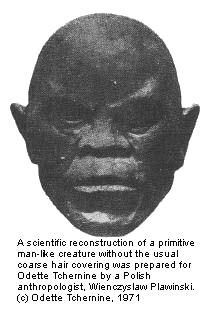 Is
there a type of prehistoric Neanderthal primitive Stone Age creature that
survives to this day? In
the last century, a yeti researcher in Mongolia, Colonel Prjevalsky, found
exciting evidence of the actual existence of these creatures. But government
influence discouraged him from publicizing the results of his research for
fear of ridicule. The Russians renewed scientific research in this field
in the 1950's. Then there seemed to be another shut down on the news and
some at the time thought this might again be fear of ridicule.
Is
there a type of prehistoric Neanderthal primitive Stone Age creature that
survives to this day? In
the last century, a yeti researcher in Mongolia, Colonel Prjevalsky, found
exciting evidence of the actual existence of these creatures. But government
influence discouraged him from publicizing the results of his research for
fear of ridicule. The Russians renewed scientific research in this field
in the 1950's. Then there seemed to be another shut down on the news and
some at the time thought this might again be fear of ridicule.
So the 1950's report of a sighting by Pronin in the mountain regions of
Soviet Central Asia was mocked into silence. Now current circumstances suggest
that the conspiracy of silence then was actually a veil to carry on research
work under cover. When I first began this record, the Russian operations
seemed engulfed in a repeated policy of non-communication. The little known
revelations were given to me in July of 1968. In August of that year I tried
to obtain more by making direct written approaches. Patience is always needed.
I was rewarded and at last a few more spheres of information opened up.
Contemporary Russian exploration took up in recent years where Prjevalsky was obliged to leave off and has continued undisturbed up until now. The Russian fieldwork might be on the point of revealing some very rare hominid (human like creatures) distribution. What has been discovered may be primitive remnants of a prehistory that have been able to pursue life undisturbed in the most impenetrable parts of the earth where the area has been suitable for their survival.
Current Russian fieldwork is taking place mainly in the Caucasus in Kabardinia and Balkaria. The leader of the recent expeditions is a woman scientist. Professor Jeanne Josefovna Kofman. Research is also going on in the Chatkal Range a few miles east of Tashkent and several expeditions to investigate the yeti have taken place there in recent years. Russian science papers on the expeditions aroused much interest. Since the first exploration began, 300 reports have reached Professor Kofman from eyewitnesses who have seen an unknown living being and who describe footprints and other evidence. The descriptions of such sightings by the country people who farm who remote and widely separated areas more or less tally in detail.
Professor Kofman announced her findings at a lecture she gave in March of 1966 at the Geographical Society in Moscow. From the skull reconstruction assembled from several reports emerges the likeness of a primate hominid but a very primitive one suggesting a vanished type of Homo sapiens. They conducted daily observations in the Kuruko valley for several weeks. The came to the conclusion that an unknown creature was living there, not a domestic animal, not a man. Sightings occurred at Nal'chik, the capital of Kabardinia. The yeti observed there was thickset and medium height.
According the Dr. Boris Porshnev, a famous historian of the Soviet Union and scholar of wide learning, people from time to time have even managed to catch the yeti and have brought them into inhabited communities but most of them soon died.
There are about ten such cases on record: in 1912, 1914, 1937, 1941 and 1954, all in mountainous regions of Russia or China. Perhaps the strangest of these stories is the tale of Zana, which took place in the last century. Zana was a female yeti who had been caught and tamed and who lived and died within the memory of a number of people still alive today. She was buried in the village of Tkhina in the Ochamchir region. Among present inhabitants of that district, more than ten were at the funeral, and more than 100 are alive who knew Zana over a long period.
At first she was lodged in a strong enclosure and she acted like a wild beast. No one ventured to give her food - it was thrown at her. She dug herself a hole in the ground and slept in it and for the three years she lived in this wild state. Then gradually she became tamer and was moved to a fenced enclosure under an awning near the house, tethered at first but later left loose to wander about. She never went far from the place where she received her food and she could not endure warm rooms. Her skin was black or dark brown and her body was covered with reddish-black hair. The shiny black hair on her head was tousled and thick. She lived for many years without showing changed - no gray hair and no falling teeth. Her teeth were enormous and she could crack anything with them. She could outrun a horse and swam the wild Movki River even when it rose in violent high tide. To gorge herself with grapes in the vineyards, she would pull down a whole vine growing around a tree. She loved wine and was allowed her fill after which she would sleep for hours in a swoon-like state.
Zana became the mother of human children. This is the fantastic side of her history and important according to those studying the science of genetics. Zana was pregnant several times by various men and gave birth without assistance but always carried the newborn child to wash it in the cold river. The half-breed infants unable to survive this chilly "baptism," died. Later when Zana gave birth, the villagers took the newborn away from her to rear themselves. Four times this happened and the children - two sons and two daughters - could talk and possessed reason. It is true they had some strange physical and mental features but they were capable of engaging in work and social life.
Let us go back a little in history and trace some of the early sightings of yeti. In the years 1905 to 1907, a young scientist B.B. Baradiyn was engaged by the Russian Geographical Society to undertake a mission across Mongolia to Tibet.
One evening just before sundown Baradiyn's caravan leader gave a yell and pointed to a strange figure clambering up a sand dune. The whole party could clearly see the head of what seemed to be a longhaired man resembling an ape. It stood there for some time then hid behind the crest of the dune.
Around 1910, V. A. Khaklov, a young geologist found two witnesses among Kazakhstan tribesmen who had seen a captive wildman in Central Asia where their Kazakhstan relatives lived. The species was male of less than medium height and covered with hair just like a young camel. But what was really striking about the creature were his long arms reaching to below his knees. He was stooped with shoulders bent forward and had a narrow, hollow looking chest. His brow was sloping and jutted out sharply above the eyes. His lower jaw was massive and he was rather chinless with a small nose and big nostrils. He had large ears with no lobes and somewhat pointed toward the rear like a fox's. The skin on his forehead, forearms and knees was horny and calloused. His legs far apart and bent at the knees. The soles of his feet resembled those of humans but were one and a half times to twice as broad with widely set toes.
Another witness found
by V. A. Khaklov had observed a wildman specimen over a period of several
months near the Manas River. That specimen, a female had been captured
by local farmers. This wild woman answered to the descriptions of yeti.
Her body was covered with hair, she was narrow chested and stooping with
inordinately long arms, widely set legs and large flat feet with spreading
toes. The feet were very broad and looked like paws. 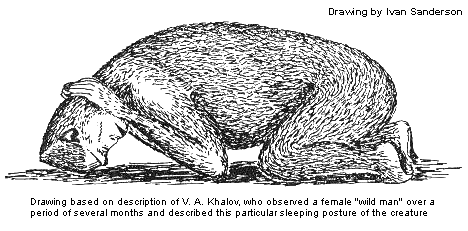 She
emitted sounds only occasionally but bared her teeth when anybody came
near her during her captivity and when she slept; it was in a peculiar
position like a camel with knees and elbows beneath her with her forehead
touching the ground - hands cupped at the back of her neck. She ate mostly
raw meat but developed a taste for flat loaves of bread. Sometimes she
seized and devoured insects that came within her reach. She drank either
by lying level to the ground and drinking like a horse or by dripping
water into her mouth with her hand. When she was set free, she walked
off clumsily; long arms dangling and then ran to the nearby swamps.
She
emitted sounds only occasionally but bared her teeth when anybody came
near her during her captivity and when she slept; it was in a peculiar
position like a camel with knees and elbows beneath her with her forehead
touching the ground - hands cupped at the back of her neck. She ate mostly
raw meat but developed a taste for flat loaves of bread. Sometimes she
seized and devoured insects that came within her reach. She drank either
by lying level to the ground and drinking like a horse or by dripping
water into her mouth with her hand. When she was set free, she walked
off clumsily; long arms dangling and then ran to the nearby swamps.
Khaklov had pictures that showed a chimpanzee, a gorilla and a reconstructed sketch of a prehistoric man. He showed the photographs to each witness at different times with a request that they indicate which of the photographs most resembled the wildman species. Both men pointed to the picture of prehistoric man.
In the summer of 1928, the eminent Mongolian Scientist, Professor Rinchen halted overnight at the home of an old Mongol woman of the Gobi, who was in her seventies. She told him how a female yeti had once nursed her at the breast. When she was a baby, her father had gone to Sinkiang with a caravan and her mother had gone to the well to water a herd of sheep, leaving her unattended in the yurt (a felt covered tent still used by these nomads). Returning with the sheep, the mother suddenly heard her child crying and noticed that the felt cover of the entrance to the yurt was thrown back. The alarmed mother rushed in and saw a hideous naked woman, her body covered with sparse hair, sitting on the women's side (east) of the yurt beside the small Mongolian crib and putting one of her long breasts into the child's mouth. The mother cried in horror and flung herself across the yurt to protect her child. The hairy creature quickly put the child down, leaped past the mother and ran out.
An old friend of Professor Rinchen, a man called Gopil, told him of a kidnapping that took place once in the Gobi in which a yeti captured a man. A caravan traveling to the town of Hoho in Inner Mongolia halted in the Gobi. One of the party went off to collect the camels that had been let loose to graze. As he was a long time returning, his companions were alarmed. One of them wanted to go off alone to search for him.. But then an old and experienced member of the party said there were yeti living in the wilderness in that part of the area and that it was dangerous for one man alone to go and look for their absent companion. So three of them set out . As they were combing the thickets they came upon a cave in a sandstone escarpment. At the entrance they saw signs that a man wearing boots has struggled with a barefooted creature. + Terrified, they did not dare enter the cave. They collected their camels, which they had left to graze nearby, and went back to the camp to get guns. However the veteran caravan man dissuaded them saying that once a yeti caught a man, it would be some days before the creature came out of the cave again. It would therefore be futile to keep watch over the cave. They continued their journey planning to free their friend on the way back.
On the return journey,
they pitched camp near the lair and three of them with rifles, hid in
the bushes near the mouth of the cave. Nothing showed itself all day but
at sundown something on two legs appeared in the opening, its whole body
covered with hair. Shots rang out and the creature fell dead. The three
men reloading their guns rushed inside the cave where they reckoned they
would find their friend and rescue him before the sound of the shots could
bring out any other yeti. They found him, but he seemed totally wild and
quite apathetic at their sudden appearance. He became strangely silent
and unwilling to say what had happened to him while he was living in the
cave. On his return home, he avoided looking people in the eye, often
turned away, and sat facing the wall when he saw they were watching him.
Two months later he died, which showed clearly that some sort of anguish
had been consuming him.
In 1968, Doctor Porshnev wrote about what he calls "the cave men
dispute" meaning the yeti. He sent me all his observations and they
were followed later by more material in 1969. Porshnev gave me an older
story he was told by retired General Mikhail Stepanovich Topil'skiy. In
1925, the general was a commissar with troops that had been sent in pursuit
of a band of White Army forces retreating through the Pamirs. In the high
region of the Vanchsk area, they hear tales of wildmen from the local
people - "beast men" who were living higher up but known for
their cries and from rare encounters.
In the Vanchsk and Yazgulemsk Ranges, the troops found bare footprints in the snow ending at the foot of a cliff face too steep to be climbed by man. They found what resembled human feces containing remains of dried berries and during a battle between the Reds and the Whites, a wounded Red soldier, an Uzbek reported that as they were firing into a cave, a wild hairy man ran out making inarticulate noises. He ran into the machine gun fire and was killed.
"At first," the general said, "I thought the thing was an ape. It was covered with fur. But I knew there were no apes in the Pamirs and moreover the body looked far more human than ape like indeed fully human."
Not far from the same locality of Yazgulem Village in the Vanchsk region, at the Fedchenko Glacier Observatory the radio meteorologist G. N. Tebenikhin experienced certain associated events, which he was completely unable to explain. "Some biped broke a rod" near the observatory then got away easily from men on skis who pursued it for several hours across a glacier. It was brown colored and it reportedly sat down and let the pursuers get closer but never nearer than one kilometer. Finally it vanished down a steep snow covered chasm sitting on its buttocks and using its feet as brakes.
The yeti, according
to Professor Rinchen seem to be vanishing in Mongolia as civilization
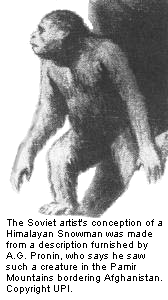 advances
into their old nomadic grounds. But their specifications still link up
with the current discoveries of Professor Kofman in the Caucasus Mountains.
Their descriptions have similarities with the stories of the yeti or snowmen
of Tibet and with the sightings and behavior of the wildmen of the Pamirs
recorded by A. G. Pronin and others. Much
of this yeti data is unknown to the rest of the world, some was found
in old ignored archives by Dr. Porshnev and his Snowman Commission of
Enquiry which seems to have been the Cinderella of Russia's official science
departments.
advances
into their old nomadic grounds. But their specifications still link up
with the current discoveries of Professor Kofman in the Caucasus Mountains.
Their descriptions have similarities with the stories of the yeti or snowmen
of Tibet and with the sightings and behavior of the wildmen of the Pamirs
recorded by A. G. Pronin and others. Much
of this yeti data is unknown to the rest of the world, some was found
in old ignored archives by Dr. Porshnev and his Snowman Commission of
Enquiry which seems to have been the Cinderella of Russia's official science
departments.
Yeti reports began in the Yablonovy, Stanovoy and Dzhugzhur Ranges. Reports also came from Lake Baikal northward to the ridge of Yenisei River Region and "God knows where else among the vast expanses of Siberia, especially to the north you will find time and time again the same stories about these wandering man-like creatures attracted particularly to herds of reindeer."
Animals have had a better deal than these rare, semi-concealed creatures. Animals are recognized and have their places in the echelon of the tree of life, but the outcasts, these unacceptable beings (insisted upon as being legend) have had the temerity to live on in a few of the rare savage places still left in the world. We are launching out into the marvels of space exploration while still not knowing everything about our own planet.
I may
be verbally flayed for what I am about to say, but perhaps after all,
we are not meant to discover the whole truth about the snowman or the
yeti. Perhaps these are the primal rough and secret stock saved by nature
to withstand and survive any final disaster preserved and hidden as raw
material for a fresh start in evolution, should we finally blow up our
so called civilization.
"How prophetic the words are in her last paragraph 20 years later...."
- ---
About the
Pamir Mountain Range.....
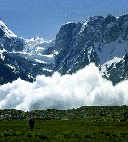 Centuries
before, Marco Polo wrote the first description of the Pamirs; he
had crossed them in the zone of present-day Afghanistan during,
his legendary journey to Cathay, and among, other things he mentions the
race of huge sheep that were later named after him.
Centuries
before, Marco Polo wrote the first description of the Pamirs; he
had crossed them in the zone of present-day Afghanistan during,
his legendary journey to Cathay, and among, other things he mentions the
race of huge sheep that were later named after him.
The ancient Silk Road went over the passes of southwestern Pamir, at the
border between Tadzhikistan and Afghanistan, as can be seen
by the many archaeological and historical finds and monuments along the
valleys: graffiti, tombs, places of worship, ruins of fortresses and castles.
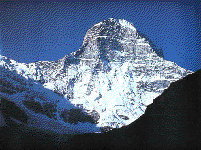 The
mountains in this region, which over-awed the first chroniclers who passed
over them, are over 6,000 meters high in many zones. They lie between
the Rushanskiy and Shakhdarinskiy ranges, Here, towering over the plateau
at the point where the Vkhan Daria and Piandzh rivers cross, there are
beautiful mountains, with very difficult routes, whose names refer to
the history of the Soviet Union....... (Photo: Engels Peak)
The
mountains in this region, which over-awed the first chroniclers who passed
over them, are over 6,000 meters high in many zones. They lie between
the Rushanskiy and Shakhdarinskiy ranges, Here, towering over the plateau
at the point where the Vkhan Daria and Piandzh rivers cross, there are
beautiful mountains, with very difficult routes, whose names refer to
the history of the Soviet Union....... (Photo: Engels Peak)
- ---
© Odette Tchernine
for ARGOSY February 1971
From the files of the late René Dahinden and more recently a clearer
copy was provided courtesy Tom Cousino with grateful appreciation Tom!
Some of these older magazine and newspaper articles contain a wealth of
information. The photos in this story were taken directly from the magazine
article where old timers will note that these images have been used in
subsequent publications following this 1971 article in Argosy.
The photos are copyrighted to Odette Tchernine and
UPI with special permission to Bigfoot Encounters,
October 4, 2001
Back to What's New?
Back to Newspaper & Magazine Articles
Home/Main
Portions of this website are reprinted and sometimes edited to fit the standards
of this website under the Fair Use Doctrine of International Copyright Law
as educational material without benefit of financial gain.
http://www4.law.cornell.edu/uscode/17/107.html
This proviso is applicable throughout the entire Bigfoot Encounters Website